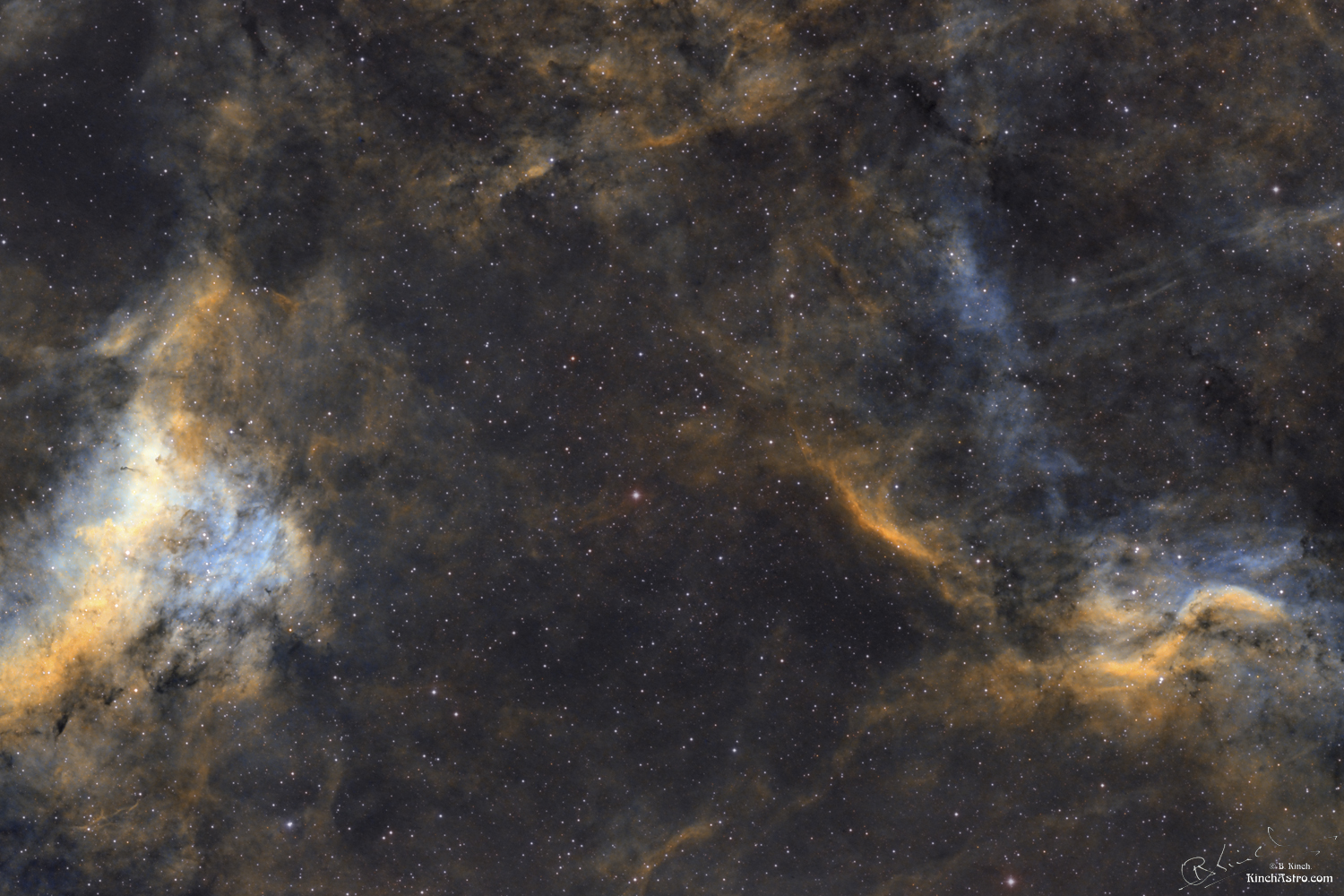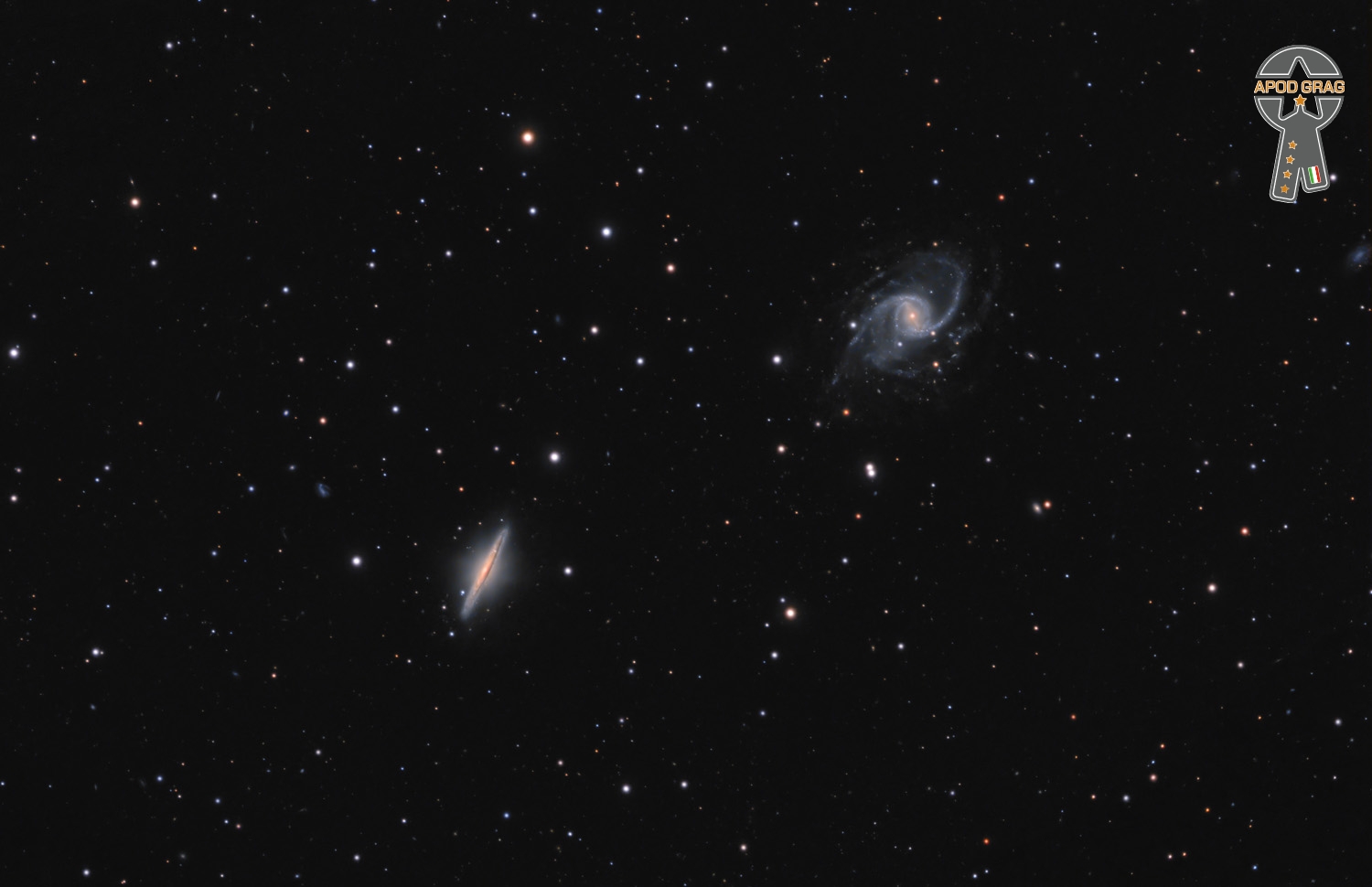Blog
DWB 111, also known as the Propeller Nebula is a hydrogen-alpha emission nebula in Cygnus. The propeller shape is actually a small portion of a much larger emission nebula. The distance to the nebula is not known.

more...
Ian Scott Anderson MBE (born 10 August 1947) is a Scottish musician, singer and songwriter best known for his work as lead vocalist, flautistand acoustic guitarist of British rock band Jethro Tull. He is a multi-instrumentalist who, in addition to flute and acoustic guitar, plays keyboards, electric guitar, bass guitar, bouzouki, balalaika, saxophone, harmonica, and a variety of whistles. His solo work began with the 1983 album Walk into Light; since then he has released another five works, including the sequel to the Jethro Tull album Thick as a Brick (1972) in 2012, entitled Thick as a Brick 2.
Ian Anderson was born in Dunfermline, Fife, Scotland, the youngest of three brothers. His father, James Anderson, ran the RSA Boiler Fluid Company in East Port, Dunfermline. Anderson’s family moved to Edinburgh when he was three. He was influenced by his father’s big band and jazz records and the emergence of rock music, but was disenchanted with the “showbiz” style of early American rock and roll stars like Elvis Presley.
more...Charles H. Israels (born August 10, 1936) is a composer, arranger, and bassist who is best known for his work with the Bill Evans Trio. He has also worked with Billie Holiday, Benny Goodman, Coleman Hawkins, Stan Getz, Herbie Hancock, J. J. Johnson, John Coltrane, and Judy Collins.
Born in New York City, Chuck Israels was raised in a musical family which moved to Cleveland, Ohio when he was 10. His stepfather Mordecai Bauman was a singer who performed extensively with composer Hanns Eisler. He, along with Israels’ mother, Irma Commanday, created a home environment in which music was a part of normal daily activity. Paul Robeson, Pete Seeger, and The Weavers were visitors to the Bauman home. In 1948, the appearance of Louis Armstrong‘s All Stars in a concert series produced by his parents gave him his first opportunity to meet and hear jazz musicians.
In college, Israels had the opportunity to perform with Billie Holiday. His first professional job after college was working with pianist Bud Powell in Paris. His first professional recording was Stereo Drive (aka Coltrane Time) with John Coltrane, Cecil Taylor, Kenny Dorham, and Louis Hayes. The recording showcased Israels as a composer with his composition “Double Clutching”. Israels is best known for his work with the Bill Evans Trio from 1961 through 1966 and for the Jazz Repertory as Director of the National Jazz Ensemble from 1973 to 1981. He made recordings with Kronos Quartetand Rosemary Clooney in 1985. He was the Director of Jazz Studies at Western Washington University in Bellingham, Washington until 2010. In 2011, he created the Chuck Israels Jazz Orchestra and recorded Second Wind: A Tribute to the Music of Bill Evans in 2013.
Humphrey Lyttelton, presenting Jazz 625 in 1965, said that Israels was “a superb technician who handles the double bass as easily as if it were a guitar…Chuck Israels is one of the reasons why musicians have come reeling away from performances by the Bill Evans Trio in a mood poised between elation and utter despair.”
more...Gertrude E. “Trudy” Pitts (August 10, 1932 – December 19, 2010) was an American soul jazz keyboardist from Philadelphia, Pennsylvania. She was known primarily for playing the Hammond B3 organ.
Trained as a musician and a music educator, Pitts studied at the Philadelphia Musical Academy, Temple University and Juilliard, as well as other institutions. Early work experience included a position as an assistant to the pianist in the Tony Award-winning musical Raisin.
At the end of the musical’s tour, she was encouraged by her husband (who had worked with Shirley Scott as a drummer) to continue developing her repertoire.
In 1967, the Boston Globe printed a piece calling her a rising star and complimented her drawbar variation, vibrato shadings, and bass pedal work.
Trudy, and her husband, William Theodore Carney II, aka Mr. C. produced and performed at many festivals and venues together; such as The Mellon Jazz Festival Organ Jams (produced by Mr. C. and Trudy), the Mary Lou Williams Jazz Festival, San Jose Organ Festival, Cliveden Jazz Festival, West Oak Lane Jazz Festival. Together they produced the “Jazz in the Sanctuary” concerts. Which featured musicians such as Grover Washington, Jr., Etta James, Houston Person, Benny Golson, and Lionel Hampton.
more...Arnett Cleophus Cobb (August 10, 1918 – March 24, 1989) was an American jazz tenor saxophonist, sometimes known as the “Wild Man of the Tenor Sax” because of his uninhibited stomping style. Cobb wrote the words and music for the jazz standard “Smooth Sailing” (1951), which Ella Fitzgerald recorded for Decca on her album Lullabies of Birdland.
Cobb then started his own seven-piece band, but suffered a serious illness in 1950, which necessitated spinal surgery. Although he re-formed the band on his recovery, in 1956 its success was again interrupted, this time by a car crash. This had long-term effects on his health, involving periods in the hospital, and making him permanently reliant on crutches. Nevertheless, Cobb worked as a soloist through the 1970s and 1980s in the U.S. and abroad. As late as 1988 he played with Jimmy Heath and Joe Henderson in Europe. He died in his hometown, at the age of 70 in 1989.
more...Clustered at the centre of this image are six luminous spots of light, four of them forming a circle around a central pair. Appearances can be deceiving, however, as this formation is not composed of six individual galaxies, but only three: to be precise, a pair of galaxies and one distant quasar. Hubble data also indicates that there is a seventh spot of light in the very center, which is a rare fifth image of the distant quasar. This rare phenomenon is caused by the presence of two galaxies in the foreground that act as a lens. These galaxies were imaged in spectacular detail by Hubble’s Wide Field Camera 3 (WFC3), which was installed on Hubble in 2009 during Hubble Servicing Mission 4, Hubble’s final servicing mission. The WFC3 was intended to operate until 2014, but 12 years after it was installed it continues to provide both top-quality data and fantastic images, such as this one. The central pair of galaxies in this image are genuinely two separate galaxies. The four bright points circling them, and the fainter one in the very center, are actually five separate images of a single quasar (known as 2M1310-1714), an extremely luminous but distant object. The reason behind this “seeing quintuple” effect is a phenomenon known as gravitational lensing. Gravitational lensing occurs when a celestial object with an enormous amount of mass — such as a pair of galaxies — causes the fabric of space to warp such that the light travelling through that space from a distant object is bent and magnified sufficiently that humans here on Earth can observe multiple magnified images of the far-away source. The quasar in this image actually lies further away from Earth than the pair of galaxies. The light from the quasar has been bent around the galaxy pair because of their enormous mass, giving the incredible appearance that the galaxy pair are surrounded by four quasars — whereas in reality, a single quasar lies far beyond them!

Jack DeJohnette (born August 9, 1942)[1] is an American jazz drummer, pianist, and composer.
An important figure of the fusion era of jazz, DeJohnette is one of the most influential jazz drummers of the 20th century, given his extensive work as leader and sideman for musicians including Charles Lloyd, Freddie Hubbard, Keith Jarrett, Bill Evans, John Abercrombie, Alice Coltrane, Sonny Rollins, Miles Davis, Joe Henderson, Michael Brecker, Herbie Hancock and John Scofield. He was inducted into the Modern Drummer Hall of Fame in 2007.
DeJohnette was born in Chicago, Illinois, to Jack DeJohnette (1911–2011) and Eva Jeanette Wood (maiden; 1918–1984) DeJohnette. Although of predominantly African American heritage, he has stated that he has some Native American ancestry, specifically Seminole and Crow. He began his musical career as a pianist, studying from age four and first playing professionally at age fourteen. He later switched focus to the drums. When Jack switched to drums he was also taught drumming techniques from a local jazz drummer who lived in the same neighborhood named Bobby Miller Jr. DeJohnette credits his uncle, Roy Wood, Sr. (1915–1995), a Chicago disc jockey and vice president/co-founder of the National Black Network of Black Broadcasters, as his inspiration to play music.
https://www.youtube.com/watch?v=VluEgxOY0as
more...Edward Rudolph “Butch” Warren Jr. (August 9, 1939 – October 5, 2013) was an American jazz bassist who was active during the 1950s and 1960s.
Warren’s mother was a typist at the CIA. His father, Edward Sr., was an electronics technician who played piano and organ part-time in clubs in Washington, D.C. The Warren home was often visited by jazz musicians Billy Hart, Jimmy Smith, and Stuff Smith. The first time Butch Warren played bass was at home on an instrument left by Billy Taylor, who had played bass for Duke Ellington. Warren has cited Jimmy Blanton, the innovative and virtuoso bassist with Ellington from 1939-1941, as his biggest inspiration. Warren began playing professionally at age 14 in a Washington, D.C. band led by his father. He later worked with other local groups, including that of Stuff Smith, as well as with altoist and bandleader Rick Henderson at the Howard Theatre. When he was 19, he sat in with Kenny Dorham to substitute for an absent bassist. A few days later, Dorham invited him to New York City, where he spent the next six months as a sideman at a club in Brooklyn. He appeared on his first recording in January 1960 with Dorham, saxophonist Charles Davis, pianist Tommy Flanagan, and drummer Buddy Enlow. Through his friendship with Sonny Clark, he recorded for Blue Note Records in 1961 on Clark’s album Leapin’ and Lopin‘. Alfred Lion, producer at Blue Note, hired Warren to fill the vacancy of staff bassist. During this job he played on “Watermelon Man” with Herbie Hancock. As sideman, he also recorded with Miles Davis, Hank Mobley, Donald Byrd, Dexter Gordon, Joe Henderson, Jackie McLean, and Stanley Turrentine.
more...NGC 5905 and NGC 5908 are two beautiful spiral galaxies in the constellation Draco. They are 140 million light years from Earth, and are about 500,000 light years apart. NGC 5905 is face-on and clearly shows its spiral structure. NGC 5908 is viewed edge-on, and so the spiral structure is hidden, and instead we see a dark band of obscuring dust.
Image captured on my remote dual rig at Fregenal de la Sierra in Spain between 1-7 June 2021.

John Renbourn (8 August 1944 – 26 March 2015) was an English guitarist and songwriter. He was best known for his collaboration with guitarist Bert Jansch as well as his work with the folk group Pentangle, although he maintained a solo career before, during and after that band’s existence (1967–1973).
While most commonly labelled a folk musician, Renbourn’s musical tastes and interests took in early music, classical music, jazz, blues and world music. His most influential album, Sir John Alot (1968), featured his take on tunes from the Medieval era.
John Renbourn studied classical guitar at school and it was during this period that he was introduced to early music. In the 1950s, along with many others, he was greatly influenced by the musical craze of skiffle and this eventually led him to explore the work of artists such as Lead Belly, Josh White and Big Bill Broonzy.
more...Urban Clifford “Urbie” Green (August 8, 1926 – December 31, 2018) was an American jazz trombonist who toured with Woody Herman, Gene Krupa, Jan Savitt, and Frankie Carle. He played on over 250 recordings and released more than two dozen albums as a soloist. He was inducted into the Alabama Jazz Hall of Fame in 1995.
Born in Mobile, Alabama, United States, Green was taught the piano as a child by his mother. He learned jazz and popular tunes from the beginning. He started to play trombone, which both older brothers played, when he was about 12. Although he listened to trombonists Tommy Dorsey, J. C. Higginbotham, Jack Jenney, Jack Teagarden and Trummy Young, he has said he was more influenced by the styles of Dizzy Gillespie, Charlie Parker, and Lester Young. His style was also influenced by the vocals of Perry Como and Louis Armstrong. At Auburn High School he was member of The Auburn Knights Orchestra.
more...Bennett Lester Carter (August 8, 1907 – July 12, 2003) was an American jazz saxophonist, clarinetist, trumpeter, composer, arranger, and bandleader. With Johnny Hodges, he was a pioneer on the alto saxophone. From the beginning of his career in the 1920s, he worked as an arranger including written charts for Fletcher Henderson‘s big band that shaped the swing style. He had an unusually long career that lasted into the 1990s. During the 1980s and ’90s, he was nominated for eight Grammy Awards, which included receiving a Lifetime Achievement Award.
Born in New York City in 1907, Carter was given piano lessons by his mother and others in the neighborhood. He played trumpet and experimented briefly with C-melody saxophone before settling on alto saxophone. In the 1920s, he performed with June Clark, Billy Paige, and Earl Hines, then toured as a member of the Wilberforce Collegians led by Horace Henderson. He appeared on record for the first time in 1927 as a member of the Paradise Ten led by Charlie Johnson. He returned to the Collegians and became their bandleader through 1929, including a performance at the Savoy Ballroom in New York City.
In his early 20s, Carter worked as arranger for Fletcher Henderson after that position was vacated by Don Redman. He had no formal education in arranging, learning by trial and error, getting on his knees and looking at the existing charts, “writing the lead trumpet first and the lead saxophone first—which, of course, is the hard way. It was quite some time that I did that before I knew what a score was.
more...https://www.youtube.com/watch?v=F4RlLG1zPP8
more...Sharpless 115 stands just north-west of Deneb, the alpha star of Cygnus, the Swan in planet Earth’s skies. Noted in the 1959 catalog by astronomer Stewart Sharpless (as Sh2-115) the faint but lovely emission nebula lies along the edge of one of the outer Milky Way’s giant molecular clouds, about 7,500 light-years away. Shining with the light of ionized atoms of hydrogen, sulfur, and oxygen in this Hubble palette color composite image, the nebular glow is powered by hot stars in star cluster Berkeley 90. The cluster stars are likely only 100 million years old or so and are still embedded in Sharpless 115. But the stars’ strong winds and radiation have cleared away much of their dusty, natal cloud. At the emission nebula’s estimated distance, this cosmic close-up spans just under 100 light-years.
SH2-116 is a small nebula that is also known as Abell 71 This object was first classified as a planetary nebula but recent studies show it to be an HII region instead. The nebula surrounding SH2-116 is indeed part of SH2-115. The nebula does not respond well with normal RGB filters but you can use a red filter as a luminance if you do not have a H-Alpha filter. Using the hydrogen-alpha filter, you can easily pick up this object without exposing a very long time using a fast system.

Marthaniel “Marcus” Roberts (born August 7, 1963) is an American jazz pianist, composer, arranger, bandleader, and teacher.
Roberts was born in Jacksonville, Florida. Blind since the age of five due to glaucoma and cataracts,[1] he attended the Florida School for the Deaf and the Blind in St. Augustine, Florida, the alma mater of blind pianist Ray Charles. Roberts began teaching himself to play piano at an early age, having his first lesson at age 12, and then studying the instrument with pianist Leonidas Lipovetsky while attending Florida State University.
In the 1980s, Roberts replaced pianist Kenny Kirkland in Wynton Marsalis’s band. Like Marsalis’s, his music is rooted in the traditional jazz of the past. His style has been influenced more by Jelly Roll Morton and Fats Waller than McCoy Tyner and Bill Evans, with an emphasis on ragtime and stride piano rather than bebop. His album New Orleans Meets Harlem, Vol. 1 (2009) covers music by Scott Joplin, Duke Ellington, Morton, and Waller.
In 1975, Kirk suffered a major stroke which led to partial paralysis of one side of his body. He continued to perform and record, modifying his instruments to enable him to play with one arm. At a live performance at Ronnie Scott’s Jazz Club in London he even managed to play two instruments, and carried on to tour internationally and to appear on television.[5]
He died from a second stroke in 1977, aged 42, the morning after performing in the Frangipani Room of the Indiana University Student Union in Bloomington, Indiana.
more...More Posts
- Daily Roots The Royals
- KARIBUNI Benedictine Living performance
- Cosmo Center of Milky Way
- Ritchie Blackmore
- Mbuta Matima
- Michael Brewer
- Ali Akbar Khan
- Gene Ammons
- World Music KARIBUNI
- Daily Roots The Crystalites
- Happy Palm Sunday 2025
- MAGA Hocus Pocus
- Survival
- Plant Seeds
- Happy Passover 2025
- Stockholm Syndrome
- Eddie Marshall
- Cosmo Markarian’s Chain
- Jack Cassady
- Lowell George